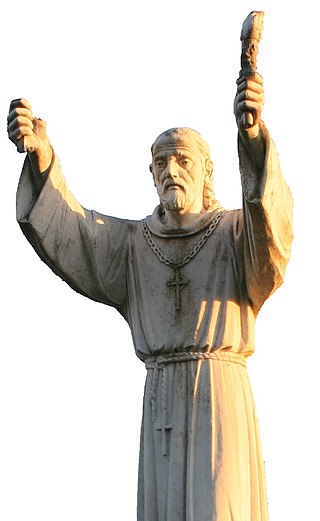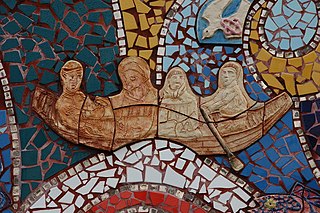
County Fermanagh is one of the thirty-two counties of Ireland, one of the nine counties of Ulster and one of six counties of Northern Ireland.

Lough Erne is the name of two connected lakes in County Fermanagh, Northern Ireland. It is the second-biggest lake system in Northern Ireland and Ulster, and the fourth biggest in Ireland. The lakes are widened sections of the River Erne, which flows north and then curves west into the Atlantic. The smaller southern lake is called the Upper Lough as it is higher up the river. The bigger northern lake is called the Lower Lough or Broad Lough. The town of Enniskillen lies on the short stretch of river between the lakes. The lake has more than 150 islands, along with many coves and inlets. The River Erne is 80 miles (129 km) long and drains an area of about 1,680 square miles (4,350 km2).

Finnian of Movilla was an Irish Christian missionary. His feast day is 10 September.

Finnian of Clonard – also Finian, Fionán or Fionnán in Irish; or Finianus and Finanus in its Latinised form (470–549) – was one of the early Irish monastic saints, who founded Clonard Abbey in modern-day County Meath. The Twelve Apostles of Ireland studied under him. Finnian of Clonard is considered one of the fathers of Irish monasticism.

Saint Comgall, an early Irish saint, was the founder and abbot of the great Irish monastery at Bangor in Ireland.
Saint Fanchea of Rossory is a saint recognized by the Orthodox Church, the Church in Wales, and the Roman Catholic Church. She was the sister of Saint Enda of Arran, whom she persuaded to become a monk. Her feast day is January 1.

The Twelve Apostles of Ireland were twelve early Irish monastic saints of the sixth century who studied under St Finnian at his famous monastic school Clonard Abbey at Cluain-Eraird, now Clonard in County Meath.
Columba of Terryglass (Colum) was the son of Ninnidh, a descendant of Crinthainn, King of Leinster. Columba was a disciple of St. Finnian of Clonard. He was one of the Twelve Apostles of Ireland.
Events from the 6th century in Ireland.
Saint Laisrén mac Nad Froích, or Laisrén of Devenish and Lasserian, known as Mo Laisse, was the patron saint of Devenish Island in Lough Erne, near Enniskillen, County Fermanagh, Ireland, in the present diocese of Clogher. Laisrén is the subject of both a Latin and an Irish Life, which offer loose narratives in which a number of miscellaneous anecdotes and miracles have been grouped together.

Tigernach mac Coirpri (d. 549) was an early Irish saint, patron saint of Clones (County Monaghan) in the province of Ulster.

Knockninny is a barony in County Fermanagh, Northern Ireland. To its east lies Upper Lough Erne, and it is bordered by four other baronies in Northern Ireland: Clanawley to the north-west; Tirkennedy to the north; Magherastephana to the north-east; and Coole to the east. It also borders two baronies in the Republic of Ireland: Loughtee Lower to the south; and Tullyhaw to the south-west.

Tirkennedy is a barony in County Fermanagh, Northern Ireland. To its west lies Lower Lough Erne and south Upper Lough Erne, and it is bordered by seven other baronies: Clanawley and Magheraboy to the west; Lurg and Omagh East to the north; Clogher to the east; Magherastephana and Knockninny to the south.

Magheraboy is a barony in County Fermanagh, Northern Ireland. To its east lies Lower Lough Erne, and it is bordered by three other baronies in Northern Ireland: Lurg to the north; Tirkennedy to the east; and Clanawley to the south It also borders two baronies in the Republic of Ireland: Tirhugh to the north; and Rosclogher to the south. The westernmost point of Magheraboy is also the westernmost point of Northern Ireland..
Garvary is a townland in the Civil Parish of Tomregan, Barony of Knockninny, County Fermanagh, Northern Ireland. (Disambiguation- see also Garvary townland, County Cavan, Republic of Ireland.)

Inishmacsaint is a monastery located on an island off the western shore of Lough Erne, County Fermanagh, Northern Ireland. The site includes the ruins of a monastic church and an early stone cross, probably from the tenth and twelfth centuries. Inishmacsaint was founded by St. Ninnidh,. The original monastic buildings were probably damaged or destroyed during the raids of the ninth or tenth centuries.

Finan Cam, Abbot of Kinnity was an early Irish saint associated with County Kerry, Ireland, who lived in the 6th century AD, and possibly the 7th century. To distinguish him from other saints of the same name the appellation of Cam or "crooked" has been given to him, either because he was stooped or because he had a squint. His feast day is 7 April.
Saint Damhnade was an Irish virgin who was known for working miracles. She is sometimes confused with Saint Dymphna. Her feast day is 13 June. Very little else is known of her.
Saint Bécán was an Irish monk who founded a monastery at Kilbeggan and is considered by some to be one of the Twelve Apostles of Ireland. His feast day is 5 April.














